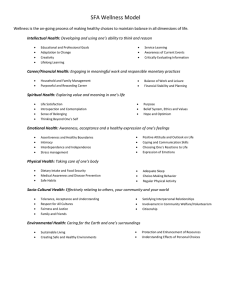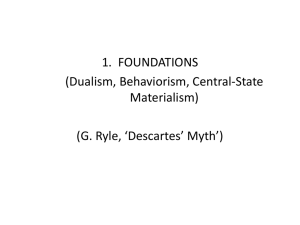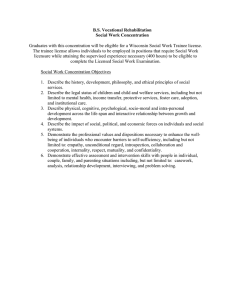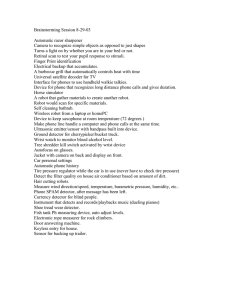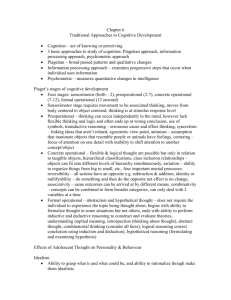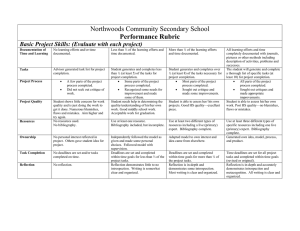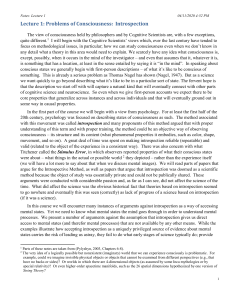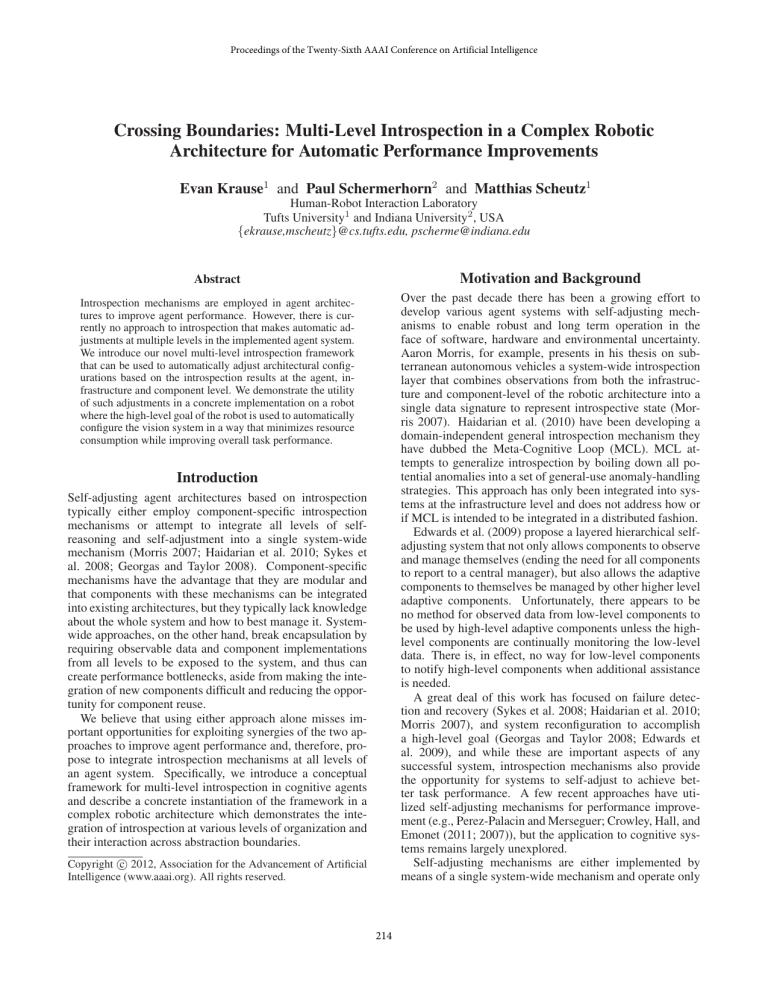
Proceedings of the Twenty-Sixth AAAI Conference on Artificial Intelligence
Crossing Boundaries: Multi-Level Introspection in a Complex Robotic
Architecture for Automatic Performance Improvements
Evan Krause1 and Paul Schermerhorn2 and Matthias Scheutz1
Human-Robot Interaction Laboratory
Tufts University1 and Indiana University2 , USA
{ekrause,mscheutz}@cs.tufts.edu, pscherme@indiana.edu
Abstract
Motivation and Background
Introspection mechanisms are employed in agent architectures to improve agent performance. However, there is currently no approach to introspection that makes automatic adjustments at multiple levels in the implemented agent system.
We introduce our novel multi-level introspection framework
that can be used to automatically adjust architectural configurations based on the introspection results at the agent, infrastructure and component level. We demonstrate the utility
of such adjustments in a concrete implementation on a robot
where the high-level goal of the robot is used to automatically
configure the vision system in a way that minimizes resource
consumption while improving overall task performance.
Over the past decade there has been a growing effort to
develop various agent systems with self-adjusting mechanisms to enable robust and long term operation in the
face of software, hardware and environmental uncertainty.
Aaron Morris, for example, presents in his thesis on subterranean autonomous vehicles a system-wide introspection
layer that combines observations from both the infrastructure and component-level of the robotic architecture into a
single data signature to represent introspective state (Morris 2007). Haidarian et al. (2010) have been developing a
domain-independent general introspection mechanism they
have dubbed the Meta-Cognitive Loop (MCL). MCL attempts to generalize introspection by boiling down all potential anomalies into a set of general-use anomaly-handling
strategies. This approach has only been integrated into systems at the infrastructure level and does not address how or
if MCL is intended to be integrated in a distributed fashion.
Edwards et al. (2009) propose a layered hierarchical selfadjusting system that not only allows components to observe
and manage themselves (ending the need for all components
to report to a central manager), but also allows the adaptive
components to themselves be managed by other higher level
adaptive components. Unfortunately, there appears to be
no method for observed data from low-level components to
be used by high-level adaptive components unless the highlevel components are continually monitoring the low-level
data. There is, in effect, no way for low-level components
to notify high-level components when additional assistance
is needed.
A great deal of this work has focused on failure detection and recovery (Sykes et al. 2008; Haidarian et al. 2010;
Morris 2007), and system reconfiguration to accomplish
a high-level goal (Georgas and Taylor 2008; Edwards et
al. 2009), and while these are important aspects of any
successful system, introspection mechanisms also provide
the opportunity for systems to self-adjust to achieve better task performance. A few recent approaches have utilized self-adjusting mechanisms for performance improvement (e.g., Perez-Palacin and Merseguer; Crowley, Hall, and
Emonet (2011; 2007)), but the application to cognitive systems remains largely unexplored.
Self-adjusting mechanisms are either implemented by
means of a single system-wide mechanism and operate only
Introduction
Self-adjusting agent architectures based on introspection
typically either employ component-specific introspection
mechanisms or attempt to integrate all levels of selfreasoning and self-adjustment into a single system-wide
mechanism (Morris 2007; Haidarian et al. 2010; Sykes et
al. 2008; Georgas and Taylor 2008). Component-specific
mechanisms have the advantage that they are modular and
that components with these mechanisms can be integrated
into existing architectures, but they typically lack knowledge
about the whole system and how to best manage it. Systemwide approaches, on the other hand, break encapsulation by
requiring observable data and component implementations
from all levels to be exposed to the system, and thus can
create performance bottlenecks, aside from making the integration of new components difficult and reducing the opportunity for component reuse.
We believe that using either approach alone misses important opportunities for exploiting synergies of the two approaches to improve agent performance and, therefore, propose to integrate introspection mechanisms at all levels of
an agent system. Specifically, we introduce a conceptual
framework for multi-level introspection in cognitive agents
and describe a concrete instantiation of the framework in a
complex robotic architecture which demonstrates the integration of introspection at various levels of organization and
their interaction across abstraction boundaries.
Copyright c 2012, Association for the Advancement of Artificial
Intelligence (www.aaai.org). All rights reserved.
214
at the infrastructure level, or are realized as highly specialized mechanisms for specific structural-level components.
While both types of introspection are integral to any successful architecture, we claim that such mechanisms need to be
simultaneously integrated at all levels of an agent system in
a granular and distributed fashion, so that synergies between
the introspection mechanisms and their ways of making adjustments at the different levels can be utilized to produce
more robust systems than any of these mechanisms alone
would be able to produce.
A Three-Level Introspection Framework
Architectures of cognitive agents consist of various, typically heterogeneous components and the way they are connected (e.g., planners, action execution, vision processing,
etc.). Similarly, architectures of agent infrastructures (sometimes also called MAS middleware) consist of various heterogeneous components for managing control and information flow in distributed systems (e.g., white and yellow page
services, discovery agents, etc.). Both kinds of architectures have components that are computational processes that
perform operations specific to their functional roles in the
agent system: in cognitive architectures, components might
perform analyses of images or sounds, parsing of natural
language expressions, or truth maintenance in a knowledge
base; in infrastructures, specialized components might perform service discovery, communication and load balancing functions, while others implement functionality specific
to the agent architecture implemented in the middleware.
The crucial idea of multi-level introspection is to integrate
component-level, infra-structure-level, and agent-level introspection. The first is performed inside every computational component, the second is performed via specialized
components, and third is performed inside some specialized
components (e.g., a reasoner).
Moreover, introspection at all three levels follows the
same three phases necessary to adjust components, their arrangements, and agent goals: self-observation, self-analysis,
and self-adjustment (Anderson and Perlis 2005). The selfobservation phase is responsible for taking note of any data
that will be useful for analysing the state of operation. Selfanalysis uses the observed data along with a set of domainspecific expectations to make hypotheses about the current state of things (e.g., an expensive process is no longer
needed), and the self-adjustment phase makes adjustments
based on the findings of the self-analysis (e.g., suspend that
process until it is needed again). Based on the introspection level, different adjustment operations are appropriate: at
the component level, component-internal algorithms are selected to optimize component operation, while at the infrastructure level system configurations are adjusted to better
utilize computational resources; finally, at the agent-level,
goals and subgoals together with their priorities are adjusted
to improved the agents’ task performance.
Figure 1: Example relationship between a high-cost algorithm Phc , and a low-cost algorithm Plc .
in tandem with one or more other components (e.g., a sentence parser component in a cognitive architecture might
rely on the output of a speech recognition component, or a
service discovery component in the infrastructure might rely
on the yellow page component).
More formally, a component consists of a set of algorithms, A = {a0 , a1 , ..., an }, where each ai is capable of
independently completing a given task. The probability of
a successful outcome s for a particular algorithm ai can be
expressed as P (s|f ), where f is an array of contributing
factors, and can include such things as robot velocity, room
noise, sensor quality, and/or light levels. Depending on the
complexity of a particular ai , P (s|f ) could be derived analytically, found experimentally (e.g., by determining falsepositive and false-negative rates under various f ), or more
abstractly by monitoring various properties of each algorithm (e.g., running time, loop time, number of iterations,
time of last iteration, time of last client use). An example
relationship between a high-cost and low-cost algorithm can
be seen in Figure 1. From here it is easy to see that:
Phc (s|f ) > Plc (s|f ) for {0 ≤ f < cf }, and
Phc (s|f ) < Plc (s|f ) for {f > cf }
where cf is some critical threshold at which Phc (s|f ) =
Plc (s|f ).
Furthermore, it is often the case that each algorithm
within a set A offers important tradeoffs between cost,
speed, and effectiveness. A low-cost speech recognizer, for
instance, might perform well in low-noise environments, but
become ineffective in noisy rooms, while an alternate recognizer might provide adequate results but at the price of high
resource use. Thus, the general goal of an introspection policy at the component-level will be to maximize P (s|f ) while
also trying to minimize cost C(ai ). Applying this policy π
to accomplish a particular component task, π is evaluated
against the current state of the component, including the currently selected algorithm, ai , to determine the appropriate
course of action, which can be a change of algorithm selection and/or a goal request to a higher level component.
Component-Level Introspection
Individual components in an agent architecture perform
highly-specialized tasks that may operate independently or
215
difference between success and failure (e.g., when additional
time constraints are imposed).
Even though introspection at the component level is often highly specialized and tailored to the specific needs and
functions of each component, we have defined a general
high-level policy that can be implemented in any component
to improve system performance.
Validation Experiments
We have implemented the introspection framework in the
robotic DIARC (distributed integrated affect, reflection,
cognition) architecture (Scheutz et al. 2007) to be able to
demonstrate the utility and effectiveness of the multi-level
introspection. Figure 2 shows a sample DIARC implementation, including the levels of introspection that are most
relevant to each component. We have chosen a simple
task and scenario in which each of the three levels of introspection (agent, infrastructure, and component) engages
in the three phases of introspection described above (selfobservation, self-analysis, and self-adjustment). In this scenario (schematically depicted in Figure 3), a robot is instructed to move down a corridor (starting at position A),
to find the “Research Lab” (D3). The location of the target
room is unknown, so the robot must visually identify signs
affixed to doors; these signs are all the same shade of blue
with the room name in black letters.
Agent-level introspection in DIARC is performed by
the DIARC goal manager, which selects the best available action to achieve the agent’s goals in its current state (Schermerhorn and Scheutz 2010). The goal
AT ( ROBOT,R ESEARCH L AB ) and the actions working toward it are monitored to ensure progress, and new actions
are selected based on agent and world states. When other
goals are instantiated, the goal manager resolves resource
conflicts in favor of the higher-priority goal.
Infrastructure-level introspection in the employed ADE
infrastructure (Scheutz 2006) is handled mainly by a dedicated infrastructure component, the ADE system registry.
The registry monitors the system, including the resource utilization on the computers hosting the components. If the
load becomes unbalanced, the registry can improve overall performance by migrating a component from a high-load
host to an idle host—assuming that no hardware constraint
(e.g., a connected camera) requires the component to run on
a specific host.
Since aspects of the agent- and infrastructure-level introspection mechanisms have already been described elsewhere, as indicated above, we focus here on componentlevel introspection in a particular DIARC component: the
DIARC vision component. The vision component features
multiple detectors for a variety of object types, and uses introspection to drive a policy for choosing between them. In
particular, for the current task, the set of algorithms A includes two detectors capable of detecting the target sign:
a1 , a blob detector that scans captured frames for regions
matching a specified RGB color range and size, and a2 , a
SIFT-based detector that compares SIFT features extracted
from frames with a database of features for the target sign.
a2 is more accurate than a1 with respect to successfully
detecting blue “Research Lab” signs in a camera frame
(i.e., Pa1 (s) < Pa2 (s)), but is also more costly in terms
of reduced frame rates and high CPU and GPU utilization
(C(a1 ) < C(a2 )).
Infrastructure-Level Introspection
Complex agent architectures, especially for robots, are often implemented in an infrastructure or middleware (e.g.,
Scheutz et al. (2007)), which itself has an architecture, not
unlike the agent architecture, with knowledge about the underlying operating environment such as available hardware,
communication between components, distribution of components across multiple hosts, and resource management.
Infrastructure-level reflection is responsible for system
state, and while it is often the case that infrastructure-only
reflection can effectively monitor and respond to these concerns, communication from other levels of reflection can allow substantial performance and utility improvements at this
level. For example, a component may be able to detect that
it is performing poorly but have no way to address the problem, while the infrastructure has no way of telling how any
given component is performing even though it is capable of
restarting or replacing the component. With inter-level communication, introspection at the component-level can provide the needed information to the infrastructure.
Agent-Level Introspection
Cognitive agents typically have knowledge about the world,
their own capabilities, and their own goals (e.g., including which goals to achieve, the time-frame in which each
goal needs to be achieved, and the relative importance of
concurrent goals). This knowledge is used by various deliberative mechanisms (planners, reasoners, etc.) to make
decisions and generate actions that lead to the accomplishment of the agent’s goals. Agent-level introspection is then
largely responsible for observing the progress of plans, detecting when plans are acceptable, when they need to be regenerated, or when certain goals are unattainable and need
to be abandoned altogether. Note that agent-level introspection is thus not concerned with the overall system state
(e.g., whether a certain component is operating correctly, or
whether there are adequate system resources).
Information from introspection mechanisms at the other
levels can be crucial for timely and successful adjustment at
the agent level. For example, assume the goal of a robot is to
(1) navigate from way-point A to way-point B and (2) take a
photograph of the location. If the camera component is inoperable, agent-only introspection would only detect a failure
after it had successfully reached way-point B and attempted
to use the camera. If, on the other hand, introspection mechanisms responsible for monitoring the camera were able to
report to the agent-level mechanism, the failure could be detected both before the robot set out toward its destination,
and during task execution (i.e., while traveling to way-point
B, but before attempting to use the camera). The robot may
be able to recover in either scenario, but it is easy to see how
communication between introspection levels could mean the
216
Figure 2: An example DIARC configuration used in the validation experiments. (a) represents the connection used by the Vision
Component to submit the “pause motion” goal, and (b) is used to carry out the goal if it is accepted by the Goal Manager.
Policy Options
the signs are likely to be fully captured in a frame processed
by a2 ). If a “Research Lab” sign is present, both a1 and a2
are very likely to detect it, and if a2 detects something, it is
very likely to be a “Research Lab” sign.
Because a1 and a2 meet these constraints, the policy can
take advantage of the cost/accuracy trade-off by running the
detector a1 under normal circumstances and switching to to
a2 when a1 detects something; a2 is used, in effect, only to
verify the judgement of a1 . The policy π is, thus, defined in
terms of simple “if-then-else” rules based on the outcomes
of running detectors: if a1 detects a target, a goal is instantiated that generates component-local actions (e.g., reconfiguring the set of running detectors) and possibly messages to
other components in the system (e.g., submitting a goal to
the goal manager, in this case to pause the motion to allow
a2 a chance to examine the scene). If a2 subsequently fails
to detect the target sign, π prescribes a switch back to the
low-cost detector to free up resources for other components.
Hence, π can be viewed as a mapping from detector-value
pairs onto the Cartesian product of the set of local actions
and the set of external actions available to the component.
A simple static policy would indicate which of the two detectors to instantiate, either to maximize P (s) or to minimize C(a). A somewhat more sophisticated policy would
include additional information about f , the known set of factors that contribute to each detectors probability of success.
The most important such factor in the validation scenario is
v, the velocity at which the robot is moving down the corridor, because it affects the likelihood that enough of a sign is
captured in a frame for a2 , the SIFT detector, to identify it
given its reduced frame rate. If the designer knows the velocity at which the robot will travel, the conditional probabilities Pa1 (s|v) and Pa2 (s|v) can be used to determine which
detector to use.
Component-level introspection in the vision component
can improve performance over such static selections by using run-time information to select the best detector given the
circumstances. The velocity may not be known in advance,
for example, in which case the vision component could monitor it and change detectors dynamically according to a policy π. In the more complex example presented here, selecting a detector in advance is impossible, because neither
detector has both acceptable accuracy and acceptable cost;
a1 is too susceptible to false positive detections, while the
impact of a2 on system load is to high to allow other components to operate effectively. Component-level introspection
allows the vision component to monitor operating conditions
and switch between the algorithms to approximate a single
detector with accuracy on a par with a2 , but at an acceptable level of cost. This works because the inaccuracy of the
color blob detector a1 with respect to “Research Lab” signs
is constrained to false positives. It is, in fact, very good at detecting “Research Lab” signs, but not at distinguishing them
from other signs in the environment. In contrast, the highaccuracy detector a2 will have very few false positives, in
addition to very few false negatives (assuming v is such that
Policy Evaluations
Three configurations were compared: static blob-only detection (C1), static SIFT-only detection (C2), and dynamic
detector switching using introspection (C3). The characteristic trajectory for each configuration is shown in Figure 3
(top). There are three doors with signs (D1, D2, and D3) in
this section of the hallway; D3 is the goal (“Research Lab”).
The CPU utilization for each is given in Figure 3 (bottom).
In (C1), the blob detector a1 is activated at the start
of the evaluation run (A in Figure 3 (top)). CPU utilization is low throughout the run, but because there are
multiple signs of the same color present, (C1) fails to locate (D3), finishing much earlier than the others due to
a false-positive identification of the target sign at (D1)—
217
reached, so it determines that an adjustment is desirable and,
by (R1), switches to a1 ; CPU utilization drops from (C2)
levels to (C1) levels.
At (D1), the component observes a positive result from
a1 . The adjustment dictated by (R2) switches to detector a2 , causing an increase in CPU utilization, somewhat
higher than (C2) levels for the first few seconds while the
detection and tracking threads are initialized.1 Because the
changeover is not instantaneous, the initialization routine
uses cross-component communication to submit a “pause
motion” goal to the goal manager.2 No match is detected
at (D1) or (as the robot moves on) at (D2), and after the
component observes the 10 second period without a positive
detection event, adjusts according to (R1), causing a2 to be
replaced again by a1 at (C) and CPU utilization to drop.
At (D3) the sign is matched by a1 , and (R2) the detector
exchange process is triggered again (along with the resulting
increase in CPU utilization). This time, the match is verified
and the result is returned to the goal manager in response to
the most recent request. The robot has arrived at its destination, so it turns toward the door and announces its arrival. No
further requests to look for doors are sent by the goal manager, and once the time threshold has been reached, (R3)
is triggered and the sign-detection subsystem is deactivated
entirely.
The CPU results in Figure 3 clearly demonstrate the benefits of introspection when the blob-based detector is active. Moreover, despite the switching overhead, the average
CPU utilization across the run for the introspection version
(M=0.177, sd=0.144) was much lower than for the SIFTonly version (M=0.297, sd=0.017), although not as low as
the blob-only configuration (M=0.069, sd=0.013). The advantages of introspection would become even more apparent in terms of shorter overall runtime and lower overall
CPU utilization during the course of longer tasks. A video is
available at http://tiny.cc/introspect, showing each of the three
conditions in action. Note that, in order to highlight the
various transitions described above, verbal indications have
been temporarily inserted when the policy dictates a change.
Figure 3: Schematic of evaluation runs (top) and CPU utilization (bottom) for (C1) static blob, (C2) static SIFT, and
(C3) dynamic introspection configurations. The robot starts
in the center of the hallway in all conditions; the three trajectories are offset here for display purposes.
the goal AT ( ROBOT,R ESEARCH L AB ) appears to have been
achieved.
In (C2), the more expensive SIFT-detection a2 is activated at the start (A), leading to consistently higher CPU
utilization. This configuration is not fooled into stopping
at (D1) or (D2), but the run ends in failure at (E) after the
robot fails to identify (D3) and drives past. Because the
sign is in the frame of the side-mounted camera for a relatively short amount of time, the slower SIFT method fails to
achieve a tracking lock (note that, although the failure could
be avoided by traveling at a slower velocity, the CPU utilization would be the same and the overall duration of task
would be longer).
The analysis policy π for (C3) is designed with two competing goals in mind: providing reliable results to client
ADE components, and minimizing resource consumption.
π consists of four rules:
Discussion
The validation results establish the potential benefits of
multi-level introspection in agent systems. Due to the threelevel design, policies at these levels can be effective (even
if not optimal) across a wide range of scenarios. This is because the effectiveness of a particular policy is a measure of
R0 enable a2 when an external request to identify target
signs is received
R1 when a2 is active for 10 seconds without detecting the
target sign, switch to a1
1
This overhead became apparent during the course of these
evaluations; we have since implemented a suspend/resume mechanism to replace the start/stop process that eliminates the restart
penalty.
2
There is no guarantee that this goal will be accepted; its priority is based on the value of the goal that triggered it (in this case
the AT ( ROBOT, R ESEARCH L AB ) goal), while its urgency is typically higher, given the short time frame within which it must be
performed. Hence, it will typically be granted priority over the
triggering goal, but another goal may have higher priority and require the motor resource. In that case, the pause goal will fail and
an accurate reading will not be made—the same as in the other
conditions.
R2 when a1 indicates a possible match, switch to a2 and
submit a “pause motion” goal to the goal manager
R3 when no external request for target signs has been received for 10 seconds, deactivate sign detection
The robot begins at (A) with neither sign-detector active,
but immediately begins receiving periodic requests (from actions being administered by the goal manager) to look for
signs and, in accordance with (R0), instantiates a2 . Via
self-observation, the component determines that no sign is
detected by the time 10 seconds have passed and (B) is
218
sures (e.g., high accuracy, low resource use) and determine
how various conditions (e.g., how frequently a particular request is received) contribute to the success or failure of a
particular policy. In that case, the programmer could simply
specify the goals and their relative priorities, and the system
could generate a policy that would attempt to achieve those
goals. Moreover, because cross-level communication is possible, this would also open the door for run-time “tweaking” of other components’ policy parameters, effectively enabling dynamically switchable policies based on the needs
and goals of higher level architecture components.
how much it contributes to achieving the goals of the entity
for which it is designed. So, for example, infrastructurelevel policies are dependent on the goals of the infrastructure (to facilitate communication, ensure reliability, etc.).
Similarly, the vision component’s goals have to do with its
local state (e.g., maximizing frame rates, response times,
etc.). The important thing to notice is that, because these
levels have (at best) limited access to the agent-level goals,
their goals are defined with reference only to their own
infrastructure- or component-internal states. For example,
locating the research lab is not a goal of the vision component, even though its policies, to the extent that they are
effective, should contribute to that goal. Hence, well-formed
policies at these levels will be applicable and effective across
a wide variety of agent-level goals and scenarios.
While the distributed nature of our approach allows for
largely self-sufficient and modular introspection mechanisms, an important aspect is also the ability of these mechanisms to reach across vertical and horizontal boundaries
when necessary. Cross-level communication in the system
can take many forms, but is achieved via a limited set of
mechanisms. The goal manager responsible for agent-level
goals is a DIARC component, so other components can submit requests just as they could to any other component, as
illustrated in the validation example when the vision component sent the “pause motion” request. Although it would
definitely be possible for the vision component to have established a connection with the robot base component and
sent the request there directly, that would require somewhat
more detailed knowledge of the interfaces implemented by
the relevant component, not to mention knowledge of which
component is the relevant one. Instead, the vision component sent the request to the goal manager. Whether the robot
was a wheeled base (as in this case), a UAV, or a biped robot,
whether it was moving or already stationary, whether a simple motion command was sufficient to stop the robot or a
goal needed to be cancelled in a motion-planning component, all were unknown and irrelevant to the vision component. The vision component neither had nor needed to know
about any of the other components in the system. The goal
manager maintains detailed knowledge of most of the components in the system so that other components do not have
to. Because of this, the vision component needed to know
about only the submit goal interface in the goal manager. Moreover, because this is actually cross-level communication between the component and the agent levels, the
agent level is given the opportunity to evaluate how the requested action will affect agent-level goals and determine
whether identifying the door is of greater importance than
continuing down the corridor.
Ideally, it will be possible for policies to be constructed
automatically, with little or no human intervention (e.g.,
specifying possible performance measures), and this is currently one limitation of our system. This will likely entail extensive data collection, evaluating performance under as many relevant condition variations and usage patterns
as possible (e.g., lighting conditions, for a vision component) and possibly some kind of learning procedure to categorize different actions according to the performance mea-
Conclusion and Future Work
We argued for the utility of employing multi-level introspection mechanisms in agent systems to automatically improve
agent performance and presented a three-level introspection
framework. Comprising agent, infrastructure, and component levels, the framework acknowledges the distinct goals,
information, and responses available at these different levels, in addition to the need for mechanisms that allow for
information sharing with or requesting aid from other levels
and components of an architecture.
We described a concrete instantiation of the framework
in the DIARC robotic architecture and presented examples demonstrating the utility of introspection on a physical
robot. Specifically, we showed that component-level introspection can be integrated both independently of, and cohesively with, higher-level mechanisms to improve system
performance during a simple robotic task by lowering system resource use and overall time to completion.
Future work will investigate how and the extent to which
policies at the different levels can be learned automatically
during task performance.
Acknowledgements
This work was in part funded by ONR MURI grant
#N00014-07-1-1049.
References
Anderson, M. L., and Perlis, D. R. 2005. Logic, selfawareness and self-improvement: The metacognitive loop
and the problem of brittleness. Journal of Logic and Computation 15(1):21–40.
Crowley, J. L.; Hall, D.; and Emonet, R. 2007. Autonomic
computer vision systems. In 2007 International Conference
on Computer Vision Systems, ICVS’07. Springer Verlag.
Edwards, G.; Garcia, J.; Tajalli, H.; Popescu, D.; Medvidovic, N.; Gaurav, S.; and Petrus, B. 2009. Architecturedriven self-adaptation and self-management in robotics systems. In Proceedings of the 2009 ICSE Workshop on Software Engineering for Adaptive and Self-Managing Systems,
142–151. Washington, DC, USA: IEEE Computer Society.
Georgas, J. C., and Taylor, R. N. 2008. Policy-based selfadaptive architectures: a feasibility study in the robotics domain. In Proceedings of the 2008 international workshop on
Software engineering for adaptive and self-managing systems, SEAMS ’08, 105–112. New York, NY, USA: ACM.
219
Haidarian, H.; Dinalankara, W.; Fults, S.; Wilson, S.; Perlis,
D.; Schmill, M.; Oates, T.; Josyula, D.; and Anderson, M.
2010. The metacognitive loop: An architecture for building robust intelligent systems. In PAAAI Fall Symposium on
Commonsense Knowledge (AAAI/CSK’10).
Morris, A. C. 2007. Robotic Introspection for Exploration
and Mapping of Subterranean Environments. Ph.D. Dissertation, Robotics Institute, Carnegie Mellon University, Pittsburgh, PA.
Perez-Palacin, D., and Merseguer, J. 2011. Performance
sensitive self-adaptive service-oriented software using hidden markov models. In Proceedings of the second joint
WOSP/SIPEW international conference on Performance engineering, ICPE ’11, 201–206. New York, NY, USA: ACM.
Schermerhorn, P., and Scheutz, M. 2010. Using logic to handle conflicts between system, component, and infrastructure
goals in complex robotic architectures. In Proceedings of the
2010 International Conference on Robotics and Automation.
Scheutz, M.; Schermerhorn, P.; Kramer, J.; and Anderson,
D. 2007. First steps toward natural human-like HRI. Autonomous Robots 22(4):411–423.
Scheutz, M. 2006. ADE - steps towards a distributed development and runtime environment for complex robotic agent
architectures. Applied Artificial Intelligence 20(4-5):275–
304.
Sykes, D.; Heaven, W.; Magee, J.; and Kramer, J. 2008.
From goals to components: a combined approach to selfmanagement. In Proceedings of the 2008 international
workshop on Software engineering for adaptive and selfmanaging systems, SEAMS ’08, 1–8. New York, NY, USA:
ACM.
220

